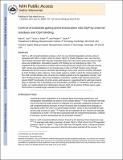Control of substrate gating and translocation into ClpP by channel residues and ClpX binding
Author(s)
Lee, Mary E.; Baker, Tania; Sauer, Robert T
DownloadBaker_Control of.pdf (1.691Mb)
OPEN_ACCESS_POLICY
Open Access Policy
Creative Commons Attribution-Noncommercial-Share Alike
Terms of use
Metadata
Show full item recordAbstract
ClpP is a self-compartmentalized protease, which has very limited degradation activity unless it associates with ClpX to form ClpXP or with ClpA to form ClpAP. Here, we show that ClpX binding stimulates ClpP cleavage of peptides larger than a few amino acids and enhances ClpP active-site modification. Stimulation requires ATP binding but not hydrolysis by ClpX. The magnitude of this enhancement correlates with increasing molecular weight of the molecule entering ClpP. Amino-acid substitutions in the channel loop or helix A of ClpP enhance entry of larger substrates into the free enzyme, eliminate ClpX binding in some cases, and are not further stimulated by ClpX binding in other instances. These results support a model in which the channel residues of free ClpP exclude efficient entry of all but the smallest peptides into the degradation chamber, with ClpX binding serving to relieve these inhibitory interactions. Specific ClpP channel variants also prevent ClpXP translocation of certain amino-acid sequences, suggesting that the wild-type channel plays an important role in facilitating broad translocation specificity. In combination with previous studies, our results indicate that collaboration between ClpP and its partner ATPases opens a gate that functions to exclude larger substrates from isolated ClpP.
Date issued
2010-04Department
Massachusetts Institute of Technology. Department of BiologyJournal
Journal of Molecular Biology
Publisher
Elsevier
Citation
Lee, Mary E., Tania A. Baker, and Robert T. Sauer. “Control of Substrate Gating and Translocation into ClpP by Channel Residues and ClpX Binding.” Journal of Molecular Biology 399.5 (2010): 707–718.
Version: Author's final manuscript
ISSN
0022-2836
1089-8638